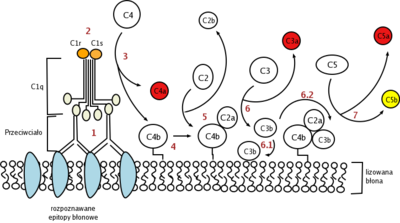
Complement component 4
Encyclopedia
Complement component 4 is a protein involved in the complement system
.
It is cleaved into proteins 4a and 4b.
C4d is the most clinically used marker for humoral rejection. It is a degradation product of the activated complement factor C4b. C4d is typically initiated by binding of antibodies to specific target molecules. Following activation and degradation of the C4 molecule, thio-ester groups are exposed, which allow transient, covalent binding of the degradation product C4d to endothelial cell surfaces and extracellular matrix components of vascular basement membranes near the sites of C4 activation. C4d is also found in intracytoplasmic vacuoles of endothelial cells. Covalent binding renders C4d a stable molecule that can easily be detected by immunohistochemistry.
Detection of C4d is regarded as an indirect sign, a ‘footprint’ of an antibody response. This observation marks a ‘revolution’: For the first time, a general and robust immunohistochemical marker for humoral rejection is identified. Since C4d is practically never detected along peritubular capillaries
in the native diseased and inflamed kidney, such as active lupus nephritis, antineutrophil cytoplasmic antibody (ANCA) disease, or anti-glomerular basement membrane (GBM) disease, its detection seems ‘transplant-specific’ . However, it should be kept in mind that, apart from the classical antibody-mediated route of complement activation, C4 can also be activated via an alternative, antibody-independent mechanism, the ‘mannan-binding lectin’ pathway. Thus, C4d may also be potentially deposited without prior antibody binding. At the current time, it is unknown whether this lectin pathway plays any pathophysiological role in the activation of C4 in renal transplants. Therefore, based on our current understanding, C4d accumulation is considered to be a marker for an ‘antibody-mediated allo-response’. The detection of C4d in a graft biopsy, in ideal circumstances, should be amended by clinical information on circulating donor-specific antibodies against major histocompatibility complex (MHC) class I or class II.

C4d has been identified as a biomarker for systemic lupus erythematosus
.
Complement system
The complement system helps or “complements” the ability of antibodies and phagocytic cells to clear pathogens from an organism. It is part of the immune system called the innate immune system that is not adaptable and does not change over the course of an individual's lifetime...
.
It is cleaved into proteins 4a and 4b.
- C4aC4AComplement C4-A is a protein that in humans is encoded by the C4A gene.-Further reading:...
is an anaphylatoxinAnaphylatoxinAnaphylatoxins, or anaphylotoxins, are fragments that are produced as part of the activation of the complement system.. Complement components C3, C4 and C5 are large glycoproteins that have important functions in the immune response and host defense...
. - C4b forms part of C3-convertaseC3-convertaseThere are two forms of C3-convertase .* The first is an enzyme composed of the C4b-C2a complex, which forms during the classical or lectin pathways of the complement system. It is formed when C1s cleaves off a small peptide fragment of C2 C2b from a membrane-bound C4b-C2a complex.* The second...
, in conjunction with 2a: - C4b can bind CR1Complement receptor 1Erythrocyte complement receptor 1 is a human gene....
. - C4d is the final proteolytic remnant of deposited C4b on endothelium, remains covalently attached to endothelium for little more than a week and easily detectable by antibody staining.
C4d is the most clinically used marker for humoral rejection. It is a degradation product of the activated complement factor C4b. C4d is typically initiated by binding of antibodies to specific target molecules. Following activation and degradation of the C4 molecule, thio-ester groups are exposed, which allow transient, covalent binding of the degradation product C4d to endothelial cell surfaces and extracellular matrix components of vascular basement membranes near the sites of C4 activation. C4d is also found in intracytoplasmic vacuoles of endothelial cells. Covalent binding renders C4d a stable molecule that can easily be detected by immunohistochemistry.
Detection of C4d is regarded as an indirect sign, a ‘footprint’ of an antibody response. This observation marks a ‘revolution’: For the first time, a general and robust immunohistochemical marker for humoral rejection is identified. Since C4d is practically never detected along peritubular capillaries
Peritubular capillaries
In the renal system, peritubular capillaries are tiny blood vessels that travel alongside nephrons allowing reabsorption and secretion between blood and the inner lumen of the nephron....
in the native diseased and inflamed kidney, such as active lupus nephritis, antineutrophil cytoplasmic antibody (ANCA) disease, or anti-glomerular basement membrane (GBM) disease, its detection seems ‘transplant-specific’ . However, it should be kept in mind that, apart from the classical antibody-mediated route of complement activation, C4 can also be activated via an alternative, antibody-independent mechanism, the ‘mannan-binding lectin’ pathway. Thus, C4d may also be potentially deposited without prior antibody binding. At the current time, it is unknown whether this lectin pathway plays any pathophysiological role in the activation of C4 in renal transplants. Therefore, based on our current understanding, C4d accumulation is considered to be a marker for an ‘antibody-mediated allo-response’. The detection of C4d in a graft biopsy, in ideal circumstances, should be amended by clinical information on circulating donor-specific antibodies against major histocompatibility complex (MHC) class I or class II.

Clinical significance
It is responsible for the Chido Rodgers blood group system.C4d has been identified as a biomarker for systemic lupus erythematosus
Systemic lupus erythematosus
Systemic lupus erythematosus , often abbreviated to SLE or lupus, is a systemic autoimmune disease that can affect any part of the body. As occurs in other autoimmune diseases, the immune system attacks the body's cells and tissue, resulting in inflammation and tissue damage...
.

